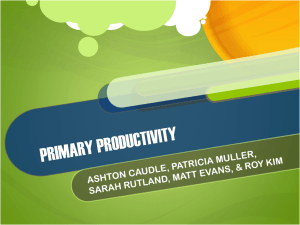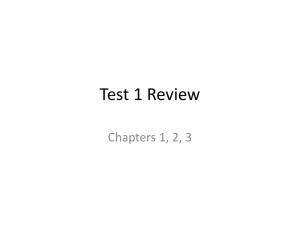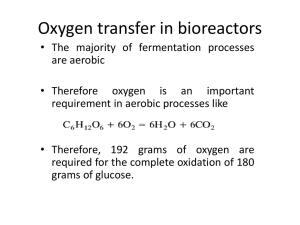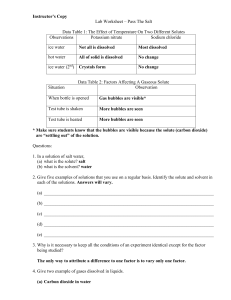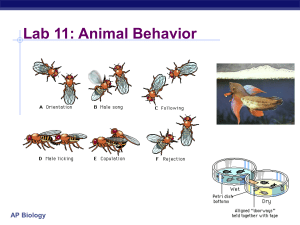Primary Production
advertisement
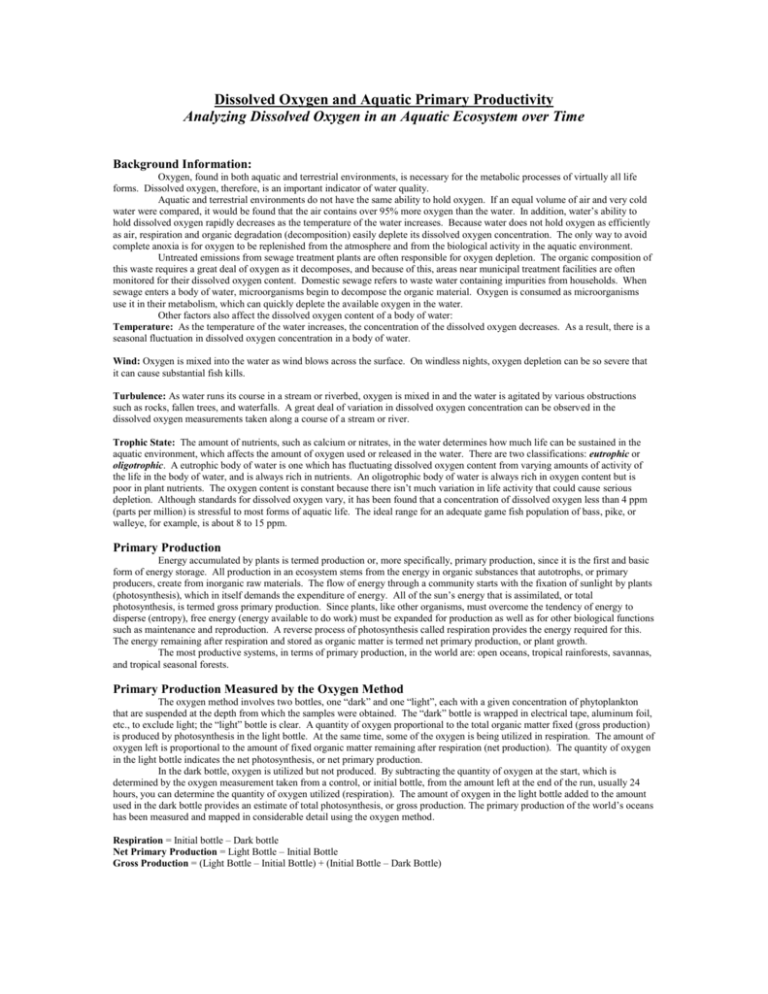
Dissolved Oxygen and Aquatic Primary Productivity Analyzing Dissolved Oxygen in an Aquatic Ecosystem over Time Background Information: Oxygen, found in both aquatic and terrestrial environments, is necessary for the metabolic processes of virtually all life forms. Dissolved oxygen, therefore, is an important indicator of water quality. Aquatic and terrestrial environments do not have the same ability to hold oxygen. If an equal volume of air and very cold water were compared, it would be found that the air contains over 95% more oxygen than the water. In addition, water’s ability to hold dissolved oxygen rapidly decreases as the temperature of the water increases. Because water does not hold oxygen as efficiently as air, respiration and organic degradation (decomposition) easily deplete its dissolved oxygen concentration. The only way to avoid complete anoxia is for oxygen to be replenished from the atmosphere and from the biological activity in the aquatic environment. Untreated emissions from sewage treatment plants are often responsible for oxygen depletion. The organic composition of this waste requires a great deal of oxygen as it decomposes, and because of this, areas near municipal treatment facilities are often monitored for their dissolved oxygen content. Domestic sewage refers to waste water containing impurities from households. When sewage enters a body of water, microorganisms begin to decompose the organic material. Oxygen is consumed as microorganisms use it in their metabolism, which can quickly deplete the available oxygen in the water. Other factors also affect the dissolved oxygen content of a body of water: Temperature: As the temperature of the water increases, the concentration of the dissolved oxygen decreases. As a result, there is a seasonal fluctuation in dissolved oxygen concentration in a body of water. Wind: Oxygen is mixed into the water as wind blows across the surface. On windless nights, oxygen depletion can be so severe that it can cause substantial fish kills. Turbulence: As water runs its course in a stream or riverbed, oxygen is mixed in and the water is agitated by various obstructions such as rocks, fallen trees, and waterfalls. A great deal of variation in dissolved oxygen concentration can be observed in the dissolved oxygen measurements taken along a course of a stream or river. Trophic State: The amount of nutrients, such as calcium or nitrates, in the water determines how much life can be sustained in the aquatic environment, which affects the amount of oxygen used or released in the water. There are two classifications: eutrophic or oligotrophic. A eutrophic body of water is one which has fluctuating dissolved oxygen content from varying amounts of activity of the life in the body of water, and is always rich in nutrients. An oligotrophic body of water is always rich in oxygen content but is poor in plant nutrients. The oxygen content is constant because there isn’t much variation in life activity that could cause serious depletion. Although standards for dissolved oxygen vary, it has been found that a concentration of dissolved oxygen less than 4 ppm (parts per million) is stressful to most forms of aquatic life. The ideal range for an adequate game fish population of bass, pike, or walleye, for example, is about 8 to 15 ppm. Primary Production Energy accumulated by plants is termed production or, more specifically, primary production, since it is the first and basic form of energy storage. All production in an ecosystem stems from the energy in organic substances that autotrophs, or primary producers, create from inorganic raw materials. The flow of energy through a community starts with the fixation of sunlight by plants (photosynthesis), which in itself demands the expenditure of energy. All of the sun’s energy that is assimilated, or total photosynthesis, is termed gross primary production. Since plants, like other organisms, must overcome the tendency of energy to disperse (entropy), free energy (energy available to do work) must be expanded for production as well as for other biological functions such as maintenance and reproduction. A reverse process of photosynthesis called respiration provides the energy required for this. The energy remaining after respiration and stored as organic matter is termed net primary production, or plant growth. The most productive systems, in terms of primary production, in the world are: open oceans, tropical rainforests, savannas, and tropical seasonal forests. Primary Production Measured by the Oxygen Method The oxygen method involves two bottles, one “dark” and one “light”, each with a given concentration of phytoplankton that are suspended at the depth from which the samples were obtained. The “dark” bottle is wrapped in electrical tape, aluminum foil, etc., to exclude light; the “light” bottle is clear. A quantity of oxygen proportional to the total organic matter fixed (gross production) is produced by photosynthesis in the light bottle. At the same time, some of the oxygen is being utilized in respiration. The amount of oxygen left is proportional to the amount of fixed organic matter remaining after respiration (net production). The quantity of oxygen in the light bottle indicates the net photosynthesis, or net primary production. In the dark bottle, oxygen is utilized but not produced. By subtracting the quantity of oxygen at the start, which is determined by the oxygen measurement taken from a control, or initial bottle, from the amount left at the end of the run, usually 24 hours, you can determine the quantity of oxygen utilized (respiration). The amount of oxygen in the light bottle added to the amount used in the dark bottle provides an estimate of total photosynthesis, or gross production. The primary production of the world’s oceans has been measured and mapped in considerable detail using the oxygen method. Respiration = Initial bottle – Dark bottle Net Primary Production = Light Bottle – Initial Bottle Gross Production = (Light Bottle – Initial Bottle) + (Initial Bottle – Dark Bottle) This equation can be shortened to read Gross Production = Light Bottle – Dark Bottle, but without the Initial Bottle test neither respiration nor net primary production can be learned. In a modified version of this method, the bottles can represent the whole aquatic ecosystem, with the light bottle representing the daytime and the dark bottle representing the night. The oxygen content of the water is measured every two to three hours over a 24 hour period, providing data that can be plotted on a diurnal curve to show the rise and fall of oxygen during the day and night. Still another modification of the light and dark bottle method suited for terrestrial communities involves measuring the amount of carbon dioxide produced. A transparent plastic bag is placed over a sample. Air is drawn through the enclosure and passed over carbon dioxide absorbent materials. The same procedure is conducted with a dark plastic bag. The amount of carbon dioxide produced under the dark bag is a measure of respiration; under the transparent bag is the quantity of carbon dioxide equivalent to the amount of photosynthesis minus the amount of respiration. The two results added together indicate gross production. Conversion of Oxygen Data to Carbon Limnologists prefer to express primary production in terms of carbon fixed rather than oxygen evolved. Oxygen values, therefore, are often converted to carbon. One method assumes that 1 mole of oxygen is released for each mole of carbon dioxide that is fixed, as implied in the simple photosynthetic formula. The molecular weights, 44 for carbon dioxide and 32 of oxygen, are used to convert oxygen evolved to carbon dioxide consumed: 44/32 = 1.375. A measure of oxygen production over time provides a means of calculating the amount of carbon that has been found in organic compounds over a period of time. For each milliliter of oxygen produced, approximately 0.536 milligrams of carbon has been fixed. Oxygen Cycle Oxygen, free in the atmosphere and dissolved in water, is a byproduct of photosynthesis. Life-forms (microorganisms, plants, animals) use oxygen in respiration and return it to the air and water in the form of raw carbon dioxide. The carbon dioxide is utilized by various microbes and green plants as an essential raw material for carbohydrate synthesis. Photosynthesis Microorganisms such as anaerobic phototrophic bacteria, cyannobacteria, autotrophic Protists, etc., and plants sustain all life on Earth by transforming the energy of sunlight and carbon dioxide into food and oxygen: Visible light 12 H20 + 6 CO2 Chlorophyll C6H12O6 + 6 O2 + 6 H2O Dissolved Gases Surface waters in contact with a mixture of gases and water vapor absorb some of its components. There are five important gases dissolved in aquatic environments; all have biological and physiochemical functions, but they differ from one another in behavior and origin. Nitrogen, oxygen, and carbon dioxide are especially important; nitrogen and oxygen are the most abundant constituents of the atmosphere, about 78% and 21% respectively, at sea level. Water vapor is present in varying amounts up to 3% by volume. Some oxygen goes into solution if the water is undersaturated. It is about one-fourth as abundant in the air as nitrogen but is more than twice as soluble. The amount of oxygen absorbed depends on temperature, salinity, and pressure; cold water absorbs more oxygen than does warm water, salinity decreases solubility, and pressure increases it. Most gases obey Henry’s Law, which states that at a constant temperature, the amount of gas absorbed by a given volume of liquid is proportional to the pressure in atmospheres that the gas exerts. Every time you open a bottle of soda pop, you see Henry’s Law in action. In releasing the pressure in the bottle, you lower the solubility of CO2, hence it comes out of solution. Carbon dioxide, however, may combine with various cations upon entering natural waters to become more abundant than the precepts of Henry’s Law dictate. It is found in both free and combined states. With the following formula, the amount of an atmospheric component found dissolved in an aquatic environment can be predicted. c=K· P c = Concentration of the gas that is absorbed K = Solubility factor (differs from gas to gas) P = Partial pressure of the gas Effect of Altitude: With an increase in altitude to a more rarefied atmosphere, the value of p in the formula decreases. Therefore, solubility, expressed as the amount of gas dissolved at equilibrium with the air, lessens. Effect of Temperature: With p constant and temperature altered, the solubility decreases as temperature rises. The inverse relationship demonstrates that cold water can hold more gas in solution than warm water. Effect of Salinity: The occurrence of various minerals in solution lowers the solubility of the gas. The reduction of saturation values of gases in seawater, when compared with distilled water, is approximately 20%. Seawater is about 35% salinity; converted to parts per million or milligrams per liter, it is about 35,000. Inland waters are “pure”, with 0% salinity in parts per thousand. Relative Saturation: Gas saturation is quantified on the basis of equilibrium at the boundary of the surface of the water and the atmosphere. Gas solubility is the ratio of its concentration in the solution to its concentration in the atmosphere. In the aquatic environment, oxygen must be in solution in a free state (O2) before it is available for use by organisms. Its concentration and distribution in the aquatic environment are directly dependent on chemical and physical factors and are greatly affected by biological processes. In the atmosphere there is an abundance of oxygen, with about 200 milliliters of oxygen for every liter of air. Conversely, in the aquatic environment there are only about 5 to 10 milliliters of dissolved oxygen in a liter of water. The concentration of the oxygen in aquatic environments is a very important component of water quality. At 20ºC oxygen diffuses 300,000 times faster in air than in water, making the distribution of oxygen in air relatively uniform. Spatial distribution of oxygen in water, on the other hand, can be highly variable, especially in the absence of mixing by currents, winds, or tides. Other chemical and physical factors, such as salinity, pH, and especially temperature, can affect the DO concentration and distribution. Salinity, usually expressed in parts per thousand (ppt), is the content of dissolved salts in water. Generally, as temperature and salinity increase, the solubility of oxygen in water decreases. (See figure below) The partial pressure of oxygen in the air above the water affects the amount of DO in the water. Less oxygen is present at higher elevations since the air itself is less dense; therefore, water at higher elevations contains less oxygen. At 4,000 meters in elevation (about 13,000 ft), the amount of dissolved oxygen in water is less than two-thirds what it is at sea level. All of these physical factors work together to increase diversity in aquatic habitats with regard to oxygen availability. Biological processes, such as photosynthesis and respiration, can also significantly affect DO concentration. Photosynthesis usually increases the DO concentration in the water. Aerobic respiration requires oxygen and will usually decrease DO concentration. The measurement of the DO concentration of a body of water is often used to determine whether the biological activities requiring oxygen are occurring; consequently, it is an important indicator of pollution. Part A: Objectives: After doing this lab you should understand: How to determine biodiversity through collection and sampling How to ask investigable questions using observations How temperature of air, soil and water are correlated How pH of soil and water are correlated How to measure UVA and UVB using probeware How to measure dissolved oxygen content using probeware, and Winkler titration methods How to assess aquatic fitness based on the above measurements Other Possible Variables Include: Turbidity flow rate pH UVA/UVB conductivity/salinity ambient and soil temperature This is the introduction of the Dissolved Oxygen and Primary Productivity lab (Official Lab 12). Most of this lab will be accomplished at the Harriet Creek, which runs along the periphery of NHS property, some at Turner Falls, Ok, and some at the OLC. We will do a comparative study of all three aquatic ecosystems. We will be collecting similar data every month through April of next year at Harriet Creek. Each group will be collecting water temperature and DO content using two methods. The first method is manual, using an aquatic thermometer and a titration called Winkler. The other method you will use is with probeware. Besides temperature and DO, lab groups will also choose ONE other variable to test that is of interest (see list above). You will be given the opportunity to make environmental observations, both quantitative and qualitative in this lab. We will have the opportunity to practice each method in class before actually using it in the field. First, you will design a data table in your quadrille which can contain quantitative data that is collected. The data table should be well thought out. You will need to accommodate data for one day each month, between September and April. Each month, you’ll collect temperature using probeware, and aquatic thermometers, and Dissolved Oxygen using Winkler Titration, and probeware. You will also need an area in your data table that can contain your group’s variable, whatever that may be. You will also need a place to record nomogram readings (which measures % saturation), as well as qualitative data. Part B Objectives: After doing this lab you should understand: The biological importance of carbon and oxygen cycling in ecosystems How primary productivity relates to the metabolism of organisms in an ecosystem The physical and biological factors that affect the solubility of gases in aquatic ecosystems, and The relationship between dissolved oxygen and the processes of photosynthesis and respiration and how these processes affect primary productivity. How to measure primary productivity based on changes in dissolved oxygen in a controlled experiment, and Investigate the effects of changing light intensity on primary productivity. Dissolved Oxygen and Temperature For the DO and Primary Productivity Lab in this class, we will be collecting quantitative temperature and DO data for 6 months. We will be using the Harriet Creek, as an actual ecosystem, instead of the lab in the classroom. We will use nature as our lab! There are several brands of test kits available to determine the dissolved oxygen content of a water sample. You will be using two methods to measure DO content. The “Winkler Method” of titration will be used as the manual method to determine DO content. You will also be using the probeware to compare to the results of the manual test, which are largely reliant upon human qualitative measurement skills. Depending on the testing procedure you use, the dissolved oxygen may be measured in parts per million (ppm), milligrams per liter (mg/L), or milliters per liter (mL/L). You should be able to make basic conversions between each of these with the following information: Ppm O2 = mg O2/L Mg O2/L x 0.698 = mL O2/L From this you can also calculate the amount of carbon fixed in photosynthesis as follows: mL O2/L x 0.536 = mg carbon fixed/L Procedure: 1. Design a data table that will contain each of the following parameters: Temperature of water at Harriet Creek (using two collection techniques…probeware and manual) Dissolved Oxygen (DO) levels at Harriet Creek (using two collection techniques…probeware and manual) Enough space to collect said data once a month from September through April Nomogram reading of dissolved oxygen saturation in water sample (See following page) Your group’s variable 2. Proceed to testing site, and choose location. Thoroughly describe your location in your lab quadrille. It is important that you use the SAME site every time you take your measurements. You should select your location based upon the characteristics you which to test. (ie rapidly moving water, slowly moving water, or completely still water). 3. Determine the temperature of the water using both probeware, and thermometer, and record temperature in your data table. 4. Determine the DO of the water using both the testing methods (probeware, and manual test kit) 5. Use the probeware to measure your group’s variable. 6. Using the Nomogram of Oxygen Saturation to the right, estimate the percent saturation of DO in your sample and record this value in your data table. Note: DO NOT recreate this Nomogram in your quadrille. Simply print out a copy from this page, and glue it in your quadrille. Part C: Identifying Aquatic Organisms While at the Harriet Creek for that first visit, use a small container to collect a sample of water. You will scrape your container along the bottom, to get a good sample of the detritus (decomposing material at bottom of creek), which is where you will find most of the microscopic consumers in the pond. Also, collect some aquatic plant material (algae or other), as another possible food source for the consumers. We will be saving these samples for the future. Procedure: 1. Make wet mount slides of water samples and observe them under a compound microscope. Use the General Guide to Aquatic Organisms that has been included to help you identify the organisms on each slide. Use the dissecting binocular microscopes and Petri dishes to observe macroinvertebrates which may be present. 2. Create a data table in your quadrille that can contain illustrations and identifications of the organisms you’ve observed. Classify them as producers or consumers. Analysis Questions 1. At what temperature was the dissolved oxygen concentration the highest? Lowest? Why do you think that’s the case? 2. Why might trout be found in pools of water shaded by trees and shrubs more commonly than in water where the trees have been cleared? 3. Observe and analyze all the data you have collected each month, and discuss how temperature affects the solubility of oxygen in water. 4. Would you expect to find higher dissolved oxygen content in a body of water in winter or summer? Why? 5. List and discuss three factors that could influence the dissolved oxygen concentration of a body of water 6. Do you think it would be wise to stock a pond with game fish if it had a dissolved oxygen content of 3 ppm? Why or why not? 7. In a double bubble map, list at least three similarities and three differences between photosynthesis and respiration. 8. Identify and discuss three careers in which the knowledge and measuring of dissolved oxygen may be required. Productivity of a body of water can be estimated by measuring the productivity of water samples and then plotting the rates on a depth profile graph. To create a depth profile, the degree to which the body of water attenuates (reduces) light must be known. Usually these data are generated by photometer readings. An estimate of the compensation level is done using a Secchi disk in deep water from a dock. From shallow water you can use a turbidity tube. Data was collected from two lakes using a Secchi disk: % of Incident Light 100% 65% 25% 10% 2% Lake One Depth (meters) 0.0 0.5 1.5 2.5 4.0 % of Incident Light 100% 65% 25% 10% 2% Lake Two Depth (meters) 0.0 1.5 4.0 7.0 11.0 9. Based on your analysis of the two lakes, which lake is more productive, and why? Limnologists prefer to express primary production in terms of carbon fixed rather than oxygen evolved. Oxygen values, therefore, are often converted to carbon. One method assumes that 1 mole of oxygen is released for each mole of carbon dioxide that is fixed, as implied in the simple photosynthetic formula. The molecular weights, 44 for carbon dioxide, and 32 for oxygen, are used to convert oxygen evolved to carbon dioxide consumed: 44/32 = 1.375. A measure of oxygen production over time provides a means of calculating the amount of carbon that has been found in organic compounds over a period of time. For each milliliter of oxygen produced, approximately 0.536 milligrams of carbon has been fixed. To calculate the amount of carbon fixed during photosynthesis use the following formula (where 0.536 mg C/mL O 2 represents the ratio between a given mass of carbon (C) fixed in sugar and the volume of oxygen (O2) released during that fixation): mL O2/L x 0.536 = mg carbon fixed/L Use the carbon productivity data (mg C/m3) from the table below to simulate primary productivity for the two data sets from lakes one and two. With this data, complete number 10. Amount of light Dissolved Oxygen Mg O2/L Dissolved Oxygen mL O2/L 6.3 7.95 7.85 7.3 6.55 5.60 4/10 4.40 5.55 5.48 5.10 4.57 3.91 2.86 Initial (100%) 100% 65% 25% 10% 2% Dark (0%) Productivity Gross mL O2/L **** 2.69 2.62 2.23 1.71 1.05 **** Net mL O2/L **** 1.15 1.08 0.70 0.17 -0.49 **** Carbon Productivity mg C/m3 **** 1440 1403 1197 917 561 **** 10. On graph paper in your quadrille, plot this converted data at the depth at which they could occur in each of these lakes. Use the graphic template below as an example of how to set up your axes. (Where + = Gross Productivity for Lake One, and ● = Gross Productivity for Lake Two) 0 4 6 8 10 Carbon Productivity in mg C/m3 1400 1200 1000 800 600 400 200 12 0 Meters in depth 2
